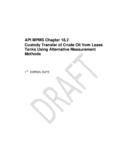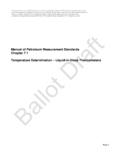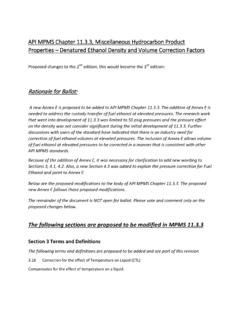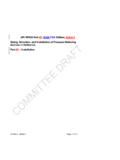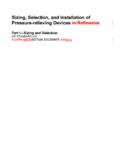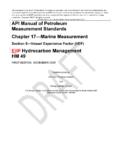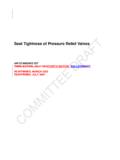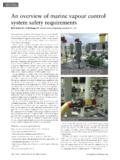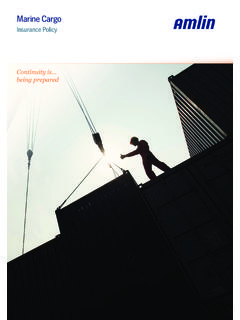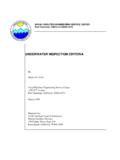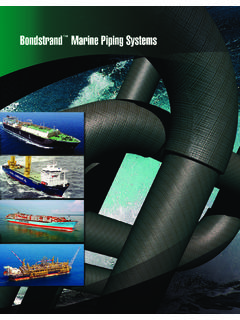Transcription of Manual of Petroleum Measurement Standards Chapter 17 ...
1 This document is not an API/EI Standard; it is under consideration within an API and EI technical committee but has not received all approvals required to become an API/EI Standard. It shall not be reproduced or circulated or quoted, in whole or in part, outside of API/EI committee activities except with the approval of the Chairman of the committee having jurisdiction. Copyright API/EI. All rights reserved. Manual of Petroleum Measurement Standards Chapter 17 Marine Measurement Section 10 Measurement of Cargoes on Board Marine Gas Carriers Part 2 Liquefied Petroleum and Chemical Gases EI Hydrocarbon Management HM 55 SECOND EDITION REVISED 2014 This document is not an API/EI Standard; it is under consideration within an API and EI technical committee but has not received all approvals required to become an API/EI Standard. It shall not be reproduced or circulated or quoted, in whole or in part, outside of API/EI committee activities except with the approval of the Chairman of the committee having jurisdiction.
2 Copyright API/EI. All rights reserved 2 TABLE OF CONTENTS * Introduction 1. 2. Normative 3. Terms and 4. General Operating Safety Precautions and Regulatory 5. Measurement Systems and 6. Measurement 7. Cargo Quantity 8. Measurement related Operational Annex A. Barge or Small Vessel Annex B. Example Annex C. Additional Instructions and Cautionary Annex D. Annex E. Physical Characteristics and Fire Bibliography *Final Table of Contents will be generated during final editing. This contents is for guidance during the balloting. This document is not an API/EI Standard; it is under consideration within an API and EI technical committee but has not received all approvals required to become an API/EI Standard. It shall not be reproduced or circulated or quoted, in whole or in part, outside of API/EI committee activities except with the approval of the Chairman of the committee having jurisdiction.
3 Copyright API/EI. All rights reserved 3 Introduction This standard provides guidance to vessel and shore personnel regarding accepted methods for determining quantities of Liquefied Petroleum and Chemical Gas cargoes on board refrigerated and/or pressurized gas carriers. It includes recommended methods for measuring, sampling, documenting and reporting quantities on board these vessels. Accounting for quantities on refrigerated and/or pressurized gas carriers requires some additional steps and care which may be contained in specific commercial agreements, operational guidelines or regulations. Other requirements should be discussed at the key meeting (pre-transfer conference), as detailed in API MPMS Chapter , or as noted in this section. All should be referred to and taken into account during the Measurement process for these cargoes. General considerations and precautions that should be taken during the Measurement of these cargoes are as follows.
4 Prior to Loading Personnel performing Measurement procedures should be made aware of the specific relevant safety and operational requirements for the refrigerated and/or pressurized gas carrier and its cargo. Specific conditions of carriage should be determined prior to loading including any relevant terminal regulations and restrictions enforced at the discharge port. It should also be determined if the cargo being loaded will be placed into tanks already containing cargo or whether the vessel s tanks need to first be prepared which may include gassing-up and cooling down operations. The amount of cargo on board prior to loading (OBQ) shall be measured, documented and reported. If tank inspection is required, it shall be carried out according to the procedure as detailed in API MPMS Chapter or other defined operating instructions and in accordance with all appropriate safety guidelines.
5 If the tank is to be gassed up and cooled down, one should account for the amount of product used in the process. See for further discussion of special operational considerations. During Loading While loading the liquid cargo, vapor in the tanks will be displaced. Either the vapor is reliquefied on board the vessel or sent ashore for reliquefaction, flaring or other combustion. The amount of vapor returned to the shore should be accounted for and the method of doing so agreed to by all parties. During Transit During the transit from the load port to the discharge port, any vaporization of the cargo is either reliquefied or vented depending on vessel configuration and regulations. Such operations should be duly noted in the vessel's logs and made available to concerned parties at the discharge port. Prior to Discharge Vessel arrival quantities should be determined and compared to quantities on board prior to sailing.
6 Any in-transit variance should be reported, an appropriate protest filed as needed and the concerned parties notified. During Discharge Any vapors supplied by the discharge port or returned to the cargo tanks to maintain proper pressure should be monitored and their source noted in the cargo inspection report. After Discharge Vessels in continuous service will often intentionally sail from the discharge port with cargo left on board after discharge (ROB) in order to keep their cargo tanks cold, gassed up and in a ready to load state at the next load port. If the tanks are to be emptied of liquid cargo (no liquid ROB) at the discharge port, the method of vaporization and the amount of vapor discharged and remaining on board should be reported. If cargo is left on board after discharge (ROB), then the amount of vapor and liquid left in the tanks should be measured, calculated, documented and reported.
7 The variance between the ROB and the on board quantity (OBQ) should be reported, and an appropriate protest filed as needed and the concerned parties notified. This document is not an API/EI Standard; it is under consideration within an API and EI technical committee but has not received all approvals required to become an API/EI Standard. It shall not be reproduced or circulated or quoted, in whole or in part, outside of API/EI committee activities except with the approval of the Chairman of the committee having jurisdiction. Copyright API/EI. All rights reserved 4 Manual of Petroleum Measurement Chapter 17 Marine Measurement Section 10 Measurement of Refrigerated and/or Pressurized Cargoes on Board Marine Gas Carriers Part 2 Liquefied Petroleum and Chemical Gases EI Hydrocarbon Management HM 55 1. Scope This standard details the steps needed to properly measure and account for the quantities of Liquefied Petroleum and Chemical Gas cargoes described in IGC Chapter 17, excluding liquefied natural gas (LNG), on board refrigerated and/or pressurized gas carriers.
8 This standard covers all Measurement systems commonly used on refrigerated and/or pressurized gas carriers designed to carry those types of cargoes. 2. Normative References The following Standards and/or other industry publications contain provisions that, through reference in this text, constitute provisions of this standard. All Standards are subject to revision, and parties to agreements based on this standard are encouraged to use the most recent editions of the Standards indicated below: API MPMS Chapter , Standard Practice for Level Measurement of Light Hydrocarbon Liquids Onboard Marine Vessels by Automatic Tank Gauging API MPMS Chapter , Measurement of Liquid Hydrocarbons by Hybrid Tank Measurement Systems API MPMS Chapter 7, Temperature Determination API MPMS Chapter , Fixed Automatic Tank Temperature Systems API MPMS Chapter , Mass Measurement of Liquid Hydrocarbons in Vertical Cylindrical Storage Tanks by Hydrostatic Tank Gauging API MPMS Chapter , Guidelines for Marine Cargo Inspection API MPMS Chapter , Measurement of Cargoes on Board Tank Vessels API MPMS Chapter , Guidelines for Pre-Loading Inspection of Marine Vessel Cargo Tanks ASTM D25981 , Standard Practice for Calculation of Certain Physical Properties of Liquefied Petroleum (LP)
9 Gases from Compositional Analysis IMO Gas Codes2 1 ASTM International, 100 Bar Harbor Drive, West Conshohocken, Pennsylvania 19428, 2 International Maritime Organization, 55 Victoria Street, London, SW1H 0EU, United Kingdom, This document is not an API/EI Standard; it is under consideration within an API and EI technical committee but has not received all approvals required to become an API/EI Standard. It shall not be reproduced or circulated or quoted, in whole or in part, outside of API/EI committee activities except with the approval of the Chairman of the committee having jurisdiction. Copyright API/EI. All rights reserved 5 International Code for the Construction and Equipment of Ships Carrying Liquefied Gases in Bulk (IGC Code) (generally applies to ships built after 17 July 1986) IMO Code for Construction and Equipment of Ships Carrying Liquefied Gases in Bulk (GC Code) (generally applies to ships built on or after 31 December 1976 but prior to 17 July 1986) IMO Code for Existing Ships Carrying Liquefied Gases (generally applies to ships delivered before 31 December 1976.)
10 3. Terms and Definitions aerating The introduction of fresh air with an acceptable dew point into the tank to purge inert gases and to increase the oxygen content to approximately 21 % of volume so as to ensure a breathable atmosphere. approved equipment Equipment that meets all applicable regulatory requirements as safe for use in a specified hazardous atmosphere. Automatic Tank Gauge (ATG) An instrument that automatically measures and displays liquid levels or ullages in one or more tanks either continuously, periodically, or on demand. Automatic Tank Thermometers (ATT) Instruments that continuously measure temperature at a specific location in a tank and typically including precision temperature sensors, tank mounted transmitters for electronic signal transmission, and receiving device(s).
